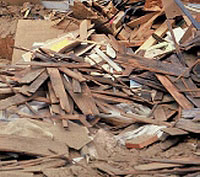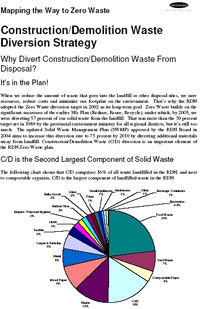Building & Bylaw ServicesCorporate Services Current PlanningDrinking Water & Watershed ProtectionEconomic DevelopmentEmergency ServicesEnergy & SustainabilityGIS/MappingLong Range PlanningParksRecreationRegional TransitSolid Waste and RecyclingWastewater ServicesWater & Utility ServicesServices by Others
Construction/Demolition Waste Diversion Strategy

In 2006, 11,000 tonnes of construction/demolition waste was received at the Regional Landfill.

Please [ Click Here ] to download a copy of the Construction/Demolition Waste Strategy.
A 2004 waste composition study determined that after organics, C/D waste is the largest component of solid waste disposed of in the Regional Landfill. The RDN's Zero Waste Plan identified the need to divert the clean wood waste from construction demolition sites from the landfill.
In February 2007 the Regional Board approved a Construction/Demolition Waste Strategy. Key initiatives in the strategy include:- Increasing the tipping fee for clean wood waste at RDN Solid Waste Facilities to create incentives to divert this material to licensed recycling facilities;
- A ban on disposal of clean wood waste in the Regional Landfill and roll-off containers of wood waste at RDN Solid Waste Facilities; and
- Arranging contracts with third party wood waste recycling facilities to manage wood waste received at the landfill and transfer station from small self-haulers.
